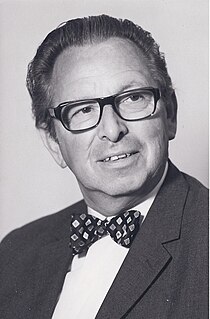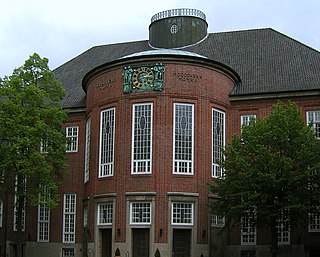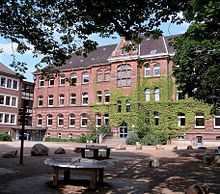
Stade, officially the Hanseatic City of Stade is a city in Lower Saxony in northern Germany. First mentioned in records in 934, it is the seat of the district which bears its name. It is located roughly 45 km (28 mi) to the west of Hamburg and belongs to that city's wider metropolitan region. Within the area of the city are the urban districts of Bützfleth, Hagen, Haddorf and Wiepenkathen, each of which have a council of their own with some autonomous decision-making rights.

Klaus von Klitzing is a German physicist, known for discovery of the integer quantum Hall effect, for which he was awarded the 1985 Nobel Prize in Physics.

The Carl von Ossietzky University of Oldenburg is a university located in Oldenburg, Germany. It is one of the most important and highly regarded educational facilities in northwestern Germany and specialises in interdisciplinary and sustainable development studies and renewable energy studies with focus on solar and wind energy.

The Wilhelmsgymnasium is a gymnasium in Munich, Germany. Founded in 1559 to educate local boys, it is now coeducational.

Gymnasium, in the German education system, is the most advanced of the three types of German secondary schools, the others being Realschule and Hauptschule. Gymnasium strongly emphasizes academic learning, comparable to the British grammar school system or with prep schools in the United States. A student attending Gymnasium is called a Gymnasiast. In 2009/10 there were 3,094 gymnasia in Germany, with c. 2,475,000 students, resulting in an average student number of 800 students per school.

The Northern Institute of Technology Management (NIT) is an educational institute located in Hamburg. The institute was founded in 1998 by 40 professors of the Hamburg University of Technology (TUHH). The first president of the NIT was the renowned scientist and former president of the TUHH, Hauke Trinks. The institute was originally founded with the name „Northern Institute of Technology“, which was extended with the addition of „Management“ in December 2007.
Dr. Hoch's Konservatorium – Musikakademie was founded in Frankfurt am Main on 22 September 1878. Through the generosity of Frankfurter Joseph Hoch, who bequeathed the Conservatory one million German gold marks in his testament, a school for music and the arts was established for all age groups. Instrumental to the foundation, prosperity and success of the conservatory was its director Joachim Raff who did most of the work including setting the entire curriculum and hiring all its faculty. It has played an important role in the history of music in Frankfurt. Clara Schumann taught piano, as one of distinguished teachers in the late 19th century, gaining international renown for the conservatory. In the 1890s, about 25% of the students came from other countries: 46 were from England and 23 from the United States.

Otto Haxel was a German nuclear physicist. During World War II, he worked on the German nuclear energy project. After the war, he was on the staff of the Max Planck Institute for Physics in Göttingen. From 1950 to 1974, he was an ordinarius professor of physics at the University of Heidelberg, where he fostered the use of nuclear physics in environmental physics; this led to the founding of the Institute of Environmental Physics in 1975. During 1956 and 1957, he was a member of the Nuclear Physics Working Group of the German Atomic Energy Commission. From 1970 to 1975, he was the Scientific and Technical Managing Director of the Karlsruhe Research Center.

The Heinrich-von-Gagern-Gymnasium is a Gymnasium with a focus on the classical humanities and modern languages in the Ostend city district of Frankfurt am Main, Germany.

The Gelehrtenschule des Johanneums is a Gymnasium in Hamburg, Germany. It is Hamburg's oldest school and was founded in 1529 by Johannes Bugenhagen. The school's focus is on the teaching of Latin and ancient Greek. It is proud of having educated some of Germany's political leaders as well as some of Germany's notable scientists. The school is operated and financed by the city of Hamburg.
Unser Lehrer Doktor Specht is a series of family author Kurt Bartsch, directors Werner Masten, Vera Loebner and Karin Hercher, shot starting in 1991 in Germany. The episodes had a length of 52 or 46 minutes. For subsequent repetitions of the episodes of the first season, the episodes were cut to about 45 minutes. In addition, they were provided with an alternative, shorter end credits sequence, which was also designed in a different font.

The Collegium Fridericianum was a prestigious gymnasium in Königsberg, Prussia. Alumni were known as Friderizianer.

The Friderico-Francisceum (FFG) is a gymnasium in Bad Doberan, Germany.

Friedrich Bachmann was a German mathematician who specialised in geometry and group theory.
Otto Follmann was a German geologist, paleontologist and educator.

The Feodor-Lynen-Gymnasium Planegg is a government secondary school in Planegg in the German state of Bavaria and belongs to the mathematical-scientific category of gymnasia but also has an economic educational branch. In April 2021 950 pupils attend the FLG, with a staff of approximately 69.

Ripening Youth is a 1933 German drama film directed by Carl Froelich and starring Heinrich George, Peter Voß and Hertha Thiele.

The Goethe-Gymnasium is a gymnasium and secondary school in Dortmund, North Rhine-Westphalia, Germany. It was founded as a school for girls in 1867, as the first school offering higher education to girls in the city. It was later named after Johann Wolfgang von Goethe. It has been a NRW Sportschule, focused on sports, from 2009.

The Artland-Gymnasium Quakenbrück (AGQ) is a secondary school in the Artland region for students in grades 5 to 13. The Gymnasium dates back to a Latin school first mentioned in 1354, making it one of the oldest schools in Lower Saxony.
The Musisches Gymnasium Frankfurt was an educational institution leading to a university entrance qualification within the framework of the National Socialist Education System. It was founded in 1939 as the first Musisches Gymnasium of the then Greater German Reich at Adolf Hitler's request and closed after the end of the Second World War in 1945. The school was under the direct supervision of the Reich Ministry of Science, Education and Culture, and the city of Frankfurt was the school authority. It became known under its director Kurt Thomas. In its internal constitution, the Musisches Gymnasium retained a special position within the National Socialist elite schools, for example through the performance of otherwise suppressed church musical works or the inclusion of confessional religious instruction in the timetable.























